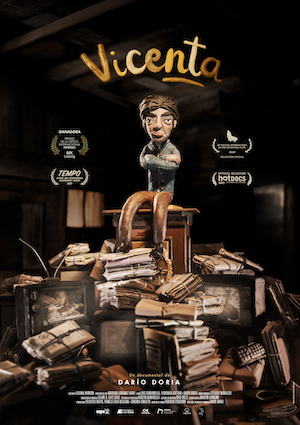
Vicenta 2020
Distributed by Pragda, 302 Bedford Ave., #136, Brooklyn, NY 11249
Produced by Virginia Croatto, Pamela Livia Delgado, and Felicitas Raffo
Directed by Darío Doria
Streaming, 69 mins
College - General Adult
Abortion; Rape; Reproductive Rights
Date Entered: 05/30/2023
Reviewed by Rachael Dreyer, Head of Research Services for Special Collections, Pennsylvania State UniversityIt would be wrong to call this film a claymation - while the figures and scenes in the documentary are made of clay, the camera is the only thing that moves. With long, slow panning shots, the voiceover narration by Liliana Herrero provides nail-biting action that unfolds at a measured pace. It is both surprising and hauntingly beautiful that the camera angles, together with the lighting that casts long shadows on the faces of the clay figures, tell the story in such a compelling way while nothing else in the camera angle moves.
Though the clay figures are fabricated, the story is not. Laura, Vicenta’s daughter, has cognitive and emotional delays - her development has not progressed past that of an eight-year-old child, though at 19, her body has matured. Vicenta, uneducated and illiterate, discovers her daughter is pregnant as the result of sexual abuse and as neither Vicenta nor Laura is able to care for an infant, she requests an abortion for her daughter. Abortion in the instance of rape is permitted under Argentine law, though the legal and medical systems engage in dual debates over the procedure. As the court case against Laura’s abuser progresses, so do her mother’s attempts to spare her the agony of childbirth, working even as the weeks of the pregnancy pass. The family receives an affirmative answer regarding the abortion; but then the procedure is derailed by the courts, who revoke and then reinstate permission for an abortion. However, by the time this has worked its way through the courts, Laura’s pregnancy is more advanced and the doctors at the hospital where she receives care are no longer willing to perform the abortion even though it is legal and allowed under Argentine law.
Though Laura ultimately obtains an abortion from a different medical practice, the process is filled with anguish and rage. The account draws a connective arc between the struggle to navigate elite systems, dependent on others, and Vicenta’s decision to seize power for herself. Her legal and medical “victory” (though it is not a victory, as abortion is only required because Laura’s bodily autonomy has been horribly, terribly violated) empowers Vicenta to return to school, to obtain a formal job with benefits after years of working off the books as a housekeeper. Viewers see a physical change in how Vicenta appears after she takes possession of her power and self-determination; her deep wrinkles and furrowed brow smooth out and her clay figurine displays the hint of a smile.
Ending with the words of the real-life Vicenta, addressing Argentine legislators, viewers are reminded that pregnancy and parenthood is nothing to be forced upon anyone - but especially not forced upon someone unable to understand the full import of how babies are conceived and birthed. Vicenta is powerful film that uses its deliberate pacing to effectively communicate the need for safe, legal, and accessible reproductive health care. With English subtitles, offers ample fodder for discussion in our post-Roe society.
Awards: International Leipzig Festival For Documentary And Animated Film, Fipresci Award; It's All True International Documentary Film Festival, Jury Special Mention
Published and licensed under the Creative Commons Attribution 4.0 license. Anyone can use these reviews, so long as they comply with the terms of the license.